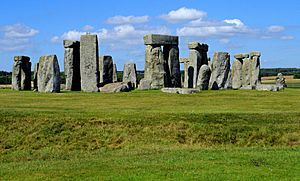Paganism facts for kids
Paganism is a word for many different spiritual and religious beliefs. Someone who follows one of these beliefs is called a Pagan. Long ago, some people who are now called Pagans believed in many gods and goddesses, not just one. The stories of Greek mythology are famous examples of an ancient pagan religion. Pagans often focus on spirituality and nature, rather than strict rules or teachings. Not all Pagans believe in many gods; some believe in only one god.
The word pagan (with a small 'p') can describe anyone whose religious beliefs are different from the main world religions. Another similar word is heathen. Today, Pagan (with a capital 'P') often refers to people who follow Neo-Pagan religions. These faiths often honor the Earth. The most well-known Neo-Pagan religion is Wicca. Another popular Neo-Pagan faith is Druidism. There are many other Neo-Pagan religions, each with their own beliefs.
Contents
Exploring Pagan and Neo-Pagan Religions
- Asatru
- Baltic paganism
- Ancient Greek religion
- Dodekatheism
- Celtic Reconstructionist Paganism
- Druidism
- Finnish paganism
- Germanic paganism
- Kemeticism
- Slavic paganism
- Wicca
Ancient Beliefs Still Alive Today
We know quite a lot about the ancient religions from places like pre-modern Africa, South America, New Guinea, and Japan. Enough information has survived to give us a clear picture. When African slaves were brought to South America and the United States, their beliefs and practices came with them. These beliefs still exist today, though they are not the main religions.
Similarly, ancient religions from groups like the Ainu in Japan also survive. The same is true for tribes in New Guinea and many tribes in the Amazon basin. We also see parts of traditional religions in African countries.
These groups often share a common history. Their religions developed before the big farming revolution that started in the Middle East. This revolution quickly spread across Eurasia. The religions that began with this change are sometimes called "religions of the book." This is because their main beliefs were written down. Writing was an important invention for settled people. It allowed them to spend time and energy on activities that would be harder for groups who moved around more.
Images for kids
-
A picture showing what the Parthenon might have looked like. It's on the Acropolis of Athens in Greece.
-
Some very large stones, called megaliths, are thought to have had religious meaning.
See also
 In Spanish: Paganismo para niños
In Spanish: Paganismo para niños









